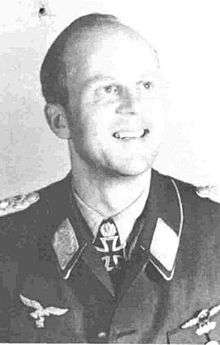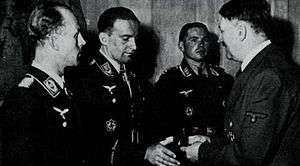Dietrich Hrabak
| Dietrich Hrabak | |
|---|---|
 Dietrich Hrabak | |
| Nickname(s) | "Dieter" |
| Born |
19 December 1914 Großdeuben, Saxony |
| Died |
15 September 1995 (aged 80) Pfaffenhofen |
| Allegiance |
|
| Service/branch |
|
| Years of service |
1934–45 1955–70 |
| Rank |
Oberst (World War II) Generalmajor (Bundeswehr) |
| Unit | JG 138, JG 76, JG 54 , JG 52 |
| Commands held | II./JG 54, JG 54, JG 52 |
| Battles/wars | |
| Awards | Knight's Cross of the Iron Cross with Oak Leaves |
| Other work | Bundeswehr |
Dietrich "Dieter" Hrabak (19 December 1914 – 15 September 1995) was a German World War II fighter ace who served in the Luftwaffe from 1935 until the end of World War II on 8 May 1945 and again in the Bundeswehr from 1955 until his retirement on 30 September 1970. A flying ace or fighter ace is a military aviator credited with shooting down five or more enemy aircraft during aerial combat.[1] During World War II he shot down 125 enemy aircraft achieved in over 1000 combat missions. 109 of his victories were claimed over the Eastern Front, with 16 against the Western Allies.
Early life and career
Hrabak was born on 19 December 1914 in Großdeuben, part of Böhlen, in the Kingdom of Saxony, a federated state of the German Empire, the son of a real estate developer. Following his graduation from the Königin-Carola-Gymnasium, a secondary school, he volunteered for military service. On 8 April 1934, Hrabak joined the Reichsmarine,[Note 1] the German navy of the Weimar Republic and in November 1935 transferred to the newly emerging Luftwaffe (German air force) as an Oberfähnrich (officer candidate). On 1 April 1936, Hrabak was promoted to Leutnant (second lieutenant).[2]
In 1938 Hrabak was posted to the Vienna Jagdgruppe, I./JG 138. This unit was later redesignated I./JG 76 during the Polish Campaign, before becoming II./JG 54 in April 1940.
World War II
During the Polish Campaign, Hrabak was shot down (the first of 11 times) on his first mission, making a belly landing. On 13 May 1940, he claimed his first victory, a French Potez 63 and he claimed five more victories before the armistice. During the Battle of Britain, Hrabak was a member of JG 54, becoming Gruppenkommandeur II./JG 54 on 26 August 1940. During the Battle of Britain he added ten victories against Royal Air Force (RAF) fighters and Field Marshal Hermann Göring personally decorated Hrabak with the Ritterkreuz ("Knight's Cross").

Hrabak served in the Balkans campaign and when Operation Barbarosa began in the Soviet Union, he flew on the northern front and over Leningrad. In November 1942, he left JG 54 to become Geschwaderkommodore of Jagdgeschwader 52 (JG 52—52nd Fighter Wing). Under Hrabak JG 52 became the highest scoring Geschwader with over 10,000 victories.
On 2 August 1943, Hrabak claimed his 100th victory. He was the 48th Luftwaffe pilot to achieve the century mark.[3] In November 1943, Eichenlaub ("Oak Leaves") were added to Hrabak's Ritterkreuz. His Oak Leaves were the 337th to be awarded. On 9 December, Hrabak was presented with them by Adolf Hitler, at the Wolfschanze, Hitler's eastern military headquarters in Rastenburg (later Kętrzyn, Poland).[4] By this time Hrabak had 118 victories.
On 20 September 1944, Hrabak scored the last of his 125 victories. In October 1944 Hrabak returned to JG 54, serving as its last Geschwaderkommodore until the end of the war. His greatest contribution to the Luftwaffe was not his combat record however but his command, tactical and leadership qualities, which endeared him to the men under his command and sealed his reputation within the Luftwaffe leadership.
Later life
After the war, he worked in the automotive and chemical industry until 1953 when Chancellor Konrad Adenauer asked him to help form the new German Air Force. In 1956 he commanded the Advanced Pilot Training Center at Fürstenfeldbruck. In 1962 he took charge of the air defense covering northern Germany and the Netherlands. In 1964 he was named NATO's Chief of Air Defense/Central Europe until becoming special manager for the Lockheed F-104 Starfighter programme. As a major general, he commanded the GAF's tactical command. General Hrabak died peacefully 15 September 1995 in Pfaffenhofen.
Awards
- Ehrenpokal der Luftwaffe (28 September 1940)[5]
- Front Flying Clasp of the Luftwaffe for fighter pilots in Gold with pennant
- Iron Cross (1939)
- German Cross in Gold on 10 July 1944 as Oberstleutnant in Jagdgeschwader 52[7]
- Knight's Cross of the Iron Cross with Oak Leaves
- Knight's Cross on 21 October 1940 as Hauptmann and Gruppenkommandeur of the II./Jagdgeschwader 54[8][9][10]
- 337th Oak Leaves on 25 November 1943 as Oberstleutnant and Geschwaderkommodore of Jagdgeschwader 52[8][11][12]
- Mentioned in the Wehrmachtbericht on 3 September 1944
Notes
- ↑ The German Reichsmarine was renamed the Kriegsmarine on 1 June 1935.
References
Citations
- ↑ Spick 1996, pp. 3–4.
- ↑ Stockert 1998, p. 171.
- ↑ Obermaier 1989, p. 243.
- ↑ Also decorated that day were Stuka ace Hptm. Hans-Ulrich Rudel, to whose Knight's Cross with Oak Leaves were added Schwertern ("Swords") , as well as Obfw. Erwin Hentschel, Rudel's air gunner/radio operator, who received the Knight's Cross.
- ↑ Obermaier 1989, p. 59.
- 1 2 Thomas 1997, p. 306.
- ↑ Patzwall & Scherzer 2001, p. 200.
- 1 2 Scherzer 2007, p. 406.
- ↑ Fellgiebel 2000, p. 236.
- ↑ Von Seemen 1976, p. 174.
- ↑ Fellgiebel 2000, p. 75.
- ↑ Von Seemen 1976, p. 39.
Bibliography
- Fellgiebel, Walther-Peer (2000) [1986]. Die Träger des Ritterkreuzes des Eisernen Kreuzes 1939–1945 — Die Inhaber der höchsten Auszeichnung des Zweiten Weltkrieges aller Wehrmachtteile [The Bearers of the Knight's Cross of the Iron Cross 1939–1945 — The Owners of the Highest Award of the Second World War of all Wehrmacht Branches] (in German). Friedberg, Germany: Podzun-Pallas. ISBN 978-3-7909-0284-6.
- Obermaier, Ernst (1989). Die Ritterkreuzträger der Luftwaffe Jagdflieger 1939 – 1945 [The Knight's Cross Bearers of the Luftwaffe Fighter Force 1939 – 1945] (in German). Mainz, Germany: Verlag Dieter Hoffmann. ISBN 978-3-87341-065-7.
- Patzwall, Klaus D.; Scherzer, Veit (2001). Das Deutsche Kreuz 1941 – 1945 Geschichte und Inhaber Band II [The German Cross 1941 – 1945 History and Recipients Volume 2] (in German). Norderstedt, Germany: Verlag Klaus D. Patzwall. ISBN 978-3-931533-45-8.
- Schaulen, Fritjof (2003). Eichenlaubträger 1940 – 1945 Zeitgeschichte in Farbe I Abraham – Huppertz [Oak Leaves Bearers 1940 – 1945 Contemporary History in Color I Abraham – Huppertz] (in German). Selent, Germany: Pour le Mérite. ISBN 978-3-932381-20-1.
- Scherzer, Veit (2007). Die Ritterkreuzträger 1939–1945 Die Inhaber des Ritterkreuzes des Eisernen Kreuzes 1939 von Heer, Luftwaffe, Kriegsmarine, Waffen-SS, Volkssturm sowie mit Deutschland verbündeter Streitkräfte nach den Unterlagen des Bundesarchives [The Knight's Cross Bearers 1939–1945 The Holders of the Knight's Cross of the Iron Cross 1939 by Army, Air Force, Navy, Waffen-SS, Volkssturm and Allied Forces with Germany According to the Documents of the Federal Archives] (in German). Jena, Germany: Scherzers Militaer-Verlag. ISBN 978-3-938845-17-2.
- Spick, Mike (1996). Luftwaffe Fighter Aces. New York: Ivy Books. ISBN 978-0-8041-1696-1.
- Stockert, Peter (1998). Die Eichenlaubträger 1939–1945 Band 4 [The Oak Leaves Bearers 1939–1945 Volume 4] (in German). Bad Friedrichshall, Germany: Friedrichshaller Rundblick. ISBN 978-3-932915-03-1.
- Thomas, Franz (1997). Die Eichenlaubträger 1939–1945 Band 1: A–K [The Oak Leaves Bearers 1939–1945 Volume 1: A–K] (in German). Osnabrück, Germany: Biblio-Verlag. ISBN 978-3-7648-2299-6.
- Von Seemen, Gerhard (1976). Die Ritterkreuzträger 1939–1945 : die Ritterkreuzträger sämtlicher Wehrmachtteile, Brillanten-, Schwerter- und Eichenlaubträger in der Reihenfolge der Verleihung : Anhang mit Verleihungsbestimmungen und weiteren Angaben [The Knight's Cross Bearers 1939–1945 : The Knight's Cross Bearers of All the Armed Services, Diamonds, Swords and Oak Leaves Bearers in the Order of Presentation: Appendix with Further Information and Presentation Requirements] (in German). Friedberg, Germany: Podzun-Verlag. ISBN 978-3-7909-0051-4.
- Die Wehrmachtberichte 1939-1945 Band 3, 1. Januar 1944 bis 9. Mai 1945 [The Wehrmacht Reports 1939–1945 Volume 3, 1 January 1944 to 9 May 1945] (in German). München, Germany: Deutscher Taschenbuch Verlag GmbH & Co. KG. 1985. ISBN 978-3-423-05944-2.
| Military offices | ||
|---|---|---|
| Preceded by Major Herbert Ihlefeld |
Commander of Jagdgeschwader 52 1 November 1942 – 30 September 1944 |
Succeeded by Oberstleutnant Hermann Graf |
| Preceded by Oberstleutnant Anton Mader |
Commander of Jagdgeschwader 54 Grünherz 1 October 1944 – 8 May 1945 |
Succeeded by none |
